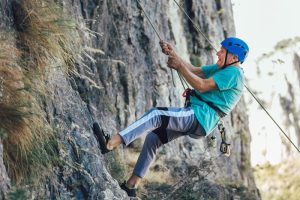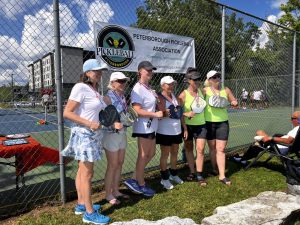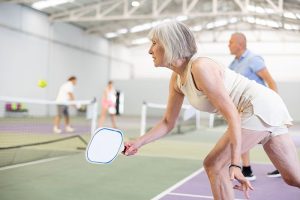Aging Habitus refers to the way our bodies, behaviors, and identities change as we age, shaped by both personal experience and social expectations. It highlights how aging isn’t just biological, but also influenced by culture, class, gender, and physical activity, affecting how we move, feel, and are perceived in society.
6
Section One: The Fundamentals
A) Keywords
Exercise 1:
Provide a brief definition of one of the padlet keywords for this week.
|
|
B) The Social Significance of Aging in Sport
Exercise 2: Notebook Prompt
How is old age popularly represented today? Find an image online that you think exemplifies one defining attitude towards old age and paste in your notebook below with a brief explanation of what this image means to you.
|
|
Exercise 3: Notebook Prompt
What does the article (referencing another study by Dionigi) mean by its statement that sport can help aging people to simultaneously “accept and resist the ageing process” (572)? Respond by audio or text and find paste two images sourced online into your notebook showing how sport might help aging people to both accept and resist the aging process.
|
The article’s statement that sport allows aging people to “accept and resist the ageing process” means that sport plays a complex role in how older adults experience aging. On one hand, it helps them accept physical changes by encouraging movement, health, and social engagement in ways that acknowledge the realities of aging. It allows them to maintain mobility, manage health issues, and stay connected with others, which are all important aspects of aging well. On the other hand, sport also allows them to resist aging by challenging stereotypes that older people are weak, inactive, or dependent. By participating in sports—especially competitive or physically demanding ones—older adults show that aging doesn’t mean giving up strength, independence, or vitality. They push back against ageist views that limit what older people are expected or allowed to do. This balance between acceptance and resistance is empowering. It gives older adults a sense of control over how they age, and it challenges society’s narrow definitions of what aging “should” look like. In short, sport becomes a space where older adults can both come to terms with aging and fight against the limitations often placed on them because of their age. |
Exercise 4: Notebook Prompt
Who are the groups less likely to have extensive opportunities to take part in sports, according to Pike? How does privilege factor into aging and sport? (200 words max)
|
According to Pike, groups less likely to have extensive opportunities to take part in sports include older adults who are women, people with disabilities, those from lower-income backgrounds, and racialized communities. These individuals often face structural barriers such as limited access to facilities, financial constraints, lack of representation, and cultural or gendered expectations that discourage participation. Privilege plays a major role in shaping how people experience aging and sport. Those with more resources—such as time, money, health, and social support—are better positioned to stay active and engage in sport as they age.
|
Exercise 5: Padlet Discussion
Why do you think age discrimination is “reported more than any form of prejudice” with older people presented as a threat to social values and interests? Feel welcome to use video in your responses. Paste your comments (or transcript of your video) below!
|
|
B) Older Women and Sport
Exercise 6: Notebook Prompt
What differences do you see in these ads? Which one is more inclusive? How is age represented or not represented in each? Answer these questions in your notebook.
|
The two ads present very different representations of age and inclusivity in sport. The first ad (Nike – “Unlimited Serena”) focuses on Serena Williams, highlighting power, intensity, and competitive excellence. While it is inspirational, it centers on a younger, elite athlete and doesn’t represent age diversity. Older women are entirely absent, reinforcing the idea that peak athleticism is tied to youth. In contrast, the second ad (This Girl Can – Sport England) is much more inclusive. It features women of different ages, body types, and backgrounds engaging in various physical activities. Older women are clearly visible and active, portrayed with confidence and joy, without being reduced to stereotypes. This ad emphasizes participation over perfection, making it feel more realistic and encouraging for viewers across age groups. The second ad is clearly more inclusive. It challenges narrow ideas of who “belongs” in sport and shows that being active isn’t limited by age. Age is not just represented—it’s embraced. This helps break down the barriers older women often face in sport, such as invisibility, lack of representation, and social pressure to “act their age.” It sends a strong message: sport is for everyone.
|
Exercise 7: Notebook Prompt
In her article, “Assessing the sociology of sport: On age and ability,” Elizabeth Pike references a “trend towards a ‘feminisation of ageing’, with many women living longer than men” (573). Do you agree that aging has been “feminized” in this way? How? Answer these questions in your notebook.
|
Yes, I agree that aging has been “feminized” in some ways, as Elizabeth Pike suggests. Since women statistically live longer than men, they make up a larger portion of the older population, which means that aging is often associated with women in both media and public discourse. However, this can lead to problematic stereotypes—older women are often portrayed as fragile, dependent, or less valuable, while older men may be seen as wise or dignified. There’s also more social pressure on women to “age well,” maintain beauty, and stay youthful. This feminization of aging can place a heavier burden on women to hide signs of aging, while also making older women more invisible in spaces like sport, media, and leadership. At the same time, older women may face both ageism and sexism, which creates added barriers to participation and recognition. So yes, aging has been feminized, but not in a way that empowers—it often reinforces inequality.
|
Section Three: Module Mini Assignment
“The Great Peterborough Pickleball Debacle” Case Study
Using the Pike article in Section One as a reference, analyze popular depictions/discussions/critiques of pickleball as a “sport trend” that has proved enormously appealing to older segments of the population.
1) Describe the problem as you understand it. Read this article for background and source two other media /social media pieces.
2) Leaving aside the clear issues with process and priorities, consider how the older pickleball athletes/advocates are represented in the media/social media discussions of the issue. Is ageism a factor in these representations? Where do you see a neoliberal agenda around aging at work in these stories (provide examples and refer back to the Pike article for guidance). Include any images you think may be relevant? (300 words)
Worth: 5%
Due: April 15th along with module work
|
1) The Problem In Peterborough, Ontario, a significant controversy has arisen over the city’s plan to redevelop Bonnerworth Park by adding 16 lighted pickleball courts. While pickleball has gained immense popularity, especially among older adults, the proposed development has faced opposition from local residents. Concerns include increased noise levels, light pollution, and the reduction of green space due to the removal of existing baseball diamonds and tennis courts. Critics also highlight a perceived lack of public consultation in the decision-making process. Despite these concerns, the city council voted against delaying the project, leading to further community unrest and the formation of groups like “Save Bonnerworth,” which has raised funds for potential legal action against the redevelopment plan. 2) Representation of Older Pickleball Athletes and the Role of Ageism and Neoliberalism Media and social media portrayals of older pickleball enthusiasts often oscillate between admiration and trivialization. On one hand, older adults are celebrated for their active lifestyles and community engagement through pickleball. On the other, they are sometimes depicted as nuisances, with complaints about noise and disruption in neighborhoods. This dichotomy reflects underlying ageist attitudes, where the activities of older adults are scrutinized more heavily than those of younger populations. Elizabeth Pike’s analysis in “Assessing the Sociology of Sport: On Age and Ability” provides insight into this phenomenon. She discusses how aging populations are often expected to remain active and self-sufficient, aligning with neoliberal ideals that emphasize individual responsibility for health and well-being. This perspective can lead to the marginalization of older adults who either cannot or choose not to conform to these expectations. In the context of the Peterborough pickleball debate, older adults advocating for recreational spaces are simultaneously lauded for their initiative and criticized for the perceived inconvenience they cause, highlighting the complex interplay of ageism and neoliberalism in public discourse.
|




